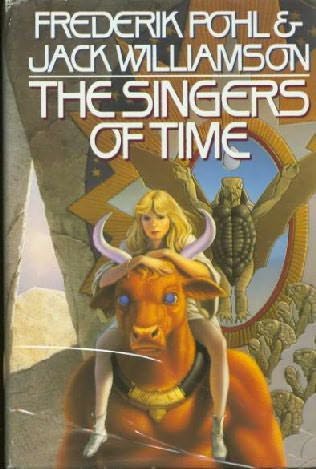

|
| Cover art by Michael Whelan |
| THE SINGERS OF TIME Frederik Pohl & Jack Williamson New York: Doubleday, February 1991 |
Rating: 5.0 High |
|||
| ISBN-13 978-0-385-26507-2 | ||||
| ISBN-10 0-385-26507-7 | 358pp. | HC | $21.95 | |
This excellent novel might well have been titled The Taur Baby. Of course, then it probably would not have been so excellent.
Anyway, to give you a flavor of it: Earth has long since been dominated by the aliens humans call Turtles, for that is what they resemble: turtles who shamble about on their hind legs, who talk in tones unreachable by humans, and who have completely remade the planet. They call themselves the Brotherhood. This name is literally true: they are all descended from a single female, the Mother to their entire race. She is an object of veneration, much as a queen bee would be if bees were intelligent.
Turtles are technologically advanced. They travel in waveships that exploit the quantum duality of particles to turn the ship and crew into waves; thus transformed, they can travel at the speed of light.1, 3 For maneuvering near planets, they use reaction drives that turn a portion of the fuel into antimatter. But this is wasteful for the commerce they value. To facilitate it, they have installed space elevators. To these they bring their purchases: all the multitudinous military hardware of the warring tribes of humans, carried up the elevators as scrap to be turned into... whatever the Turtles desire. For war is forbidden to humans — as is scientific research and, with a few carefully limited exceptions, any access to Turtle technology. The prime example is memory implants which are available only to those with whom the Turtles directly interact. A memory implant conveys the skill needed to perform some task for the Turtles, like tracking the commerce that flows up a space elevator. The implant also stores all the data produced, so that when it is unplugged from its user's head, all knowledge of the operation goes with it.
Turtles are nothing if not ardently protective of their technological advantages.
The Turtles have also brought to Earth the Taurs; bull-like but placidly intelligent, they perform menial tasks. Also, they have replaced earthly cattle. Encouraged by the Turtles, most everyone on Earth eats Taur steaks.2 But Moon Bunderan has raised her Taur, Thrayl, from a baby and thinks of it as a friend. So when the time approaches that Thrayl is to be slaughtered, she runs away from her New Mexico ranch home, taking Thrayl along. They end up aboard Francis Krake's waveship, with two Turtles, bound for the Turtle home world on a mysterious mission tied to some great catastrophe of which only Turtles and Taurs seem to be aware.
The novel is a genuine page-turner. In some ways it resembles Poul Anderson's Tau Zero — but it has plenty of original plot elements. I did not see the resolution coming, and I think you will be surprised by it as well. Between each of the book's 21 chapters there is an interlude of "songs" with a hidden didactic purpose.4 There are one or two breaks in continuity. For example, at one point the main personality traits of the two brothers Kiri and Sork are mysteriously exchanged.5 But there's not enough wrong to even make an Errata page, and none of it will detract from the reader's enjoyment.

 To contact Chris Winter, send email to this address.
To contact Chris Winter, send email to this address.